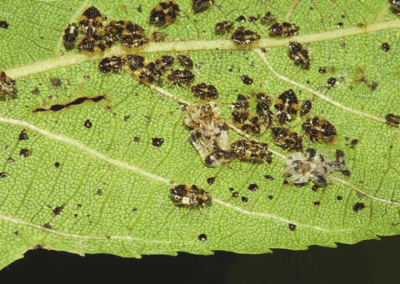Shrub Disease Treatment Services
Properly Treating Diseased Shrubs
Protecting your shrubs begins with a complete inspection of your landscape by one of our ISA-certified arborists. Our plant health care program addresses the many diseases that affect plants in our area at various times of the year.
Regular inspections enable your arborist to determine the overall health of your landscape and if needed, recommend the appropriate treatments to maintain and improve the condition of your shrubs and ornamental plantings.
Common Shrub Diseases
- Boxwood blight is caused by the fungus, Cylindrocladium pseudonaviculata. This disease causes lesions on the leaves, with lesions on stems following soon after. If not treated, the infection will cause the plant to drop its leaves, causing stress and eventual death.
- Fire blight is caused by the bacteria Erwinia amylovora. Over 130 members of the Rosaceae family are susceptible, including apple and crabapple, cotoneaster, firethorn, hawthorn, mountain ash, and pear.
- Infected leaves, stems, twigs and fruits will turn brown to black. Fire blight will blacken the smooth-barked, green branches and leaves. Affected twigs develop a “shepherd’s crook”.
- Needle, tip, or twig blights occur on many species of shrubs including arborvitae, cypress, and juniper. They start by turning the tips of twigs and ends of needles brown or grey. Black, pimple-like fungal fruiting structures may develop on needle surfaces.
- These blights can be caused by fungi in the genera Phomopsis, Diplodia or Coryneum.
- Leaf Spot causes small, irregular brown to black spots to appear on leaves, which will eventually drop prematurely. Lesions caused by Colletotrichum gloeosporioides are round, brown spots visible on both upper and lower surfaces of leaves. These fungal diseases may first appear as symptoms of winter desiccation.
- Powdery Mildew is a common fungal disease that creates a white, powdery appearance on leaves, stems, and buds. Infection often leads to leaf yellowing, premature leaf-drop, and slow growth.
- Pachysandra volutella blight targets Japanese pachysandra. The stems of an infected plant will darken and die. If conditions are particularly wet, orange/pink fungal spores will colonize the surface of dead stems. Brown and tan spots will develop on the leaves and eventually spread over the entire leaf. Concentric line patterns may be visible.
- Black spot is a fungal disease (Diplocarpon rosae) that affects roses The fungus develops as black on the leaves which eventually causes the leaves to turn yellow and drop off. Besides looking unsightly, it can seriously weaken the rose plant. Black spot thrives during hot, humid, or rainy summers and hot days with cool, damp nights.
Common Pests in Shrubs
- Boxwood psyllidis capable of infesting all species of ornamental boxwood. These insects overwinter by laying orangish eggs in between bud scales. Nymphs hatch early in the season and a white, waxy substance they secrete may cover the plant and be detrimental to its health. Psyllids suck sap from buds and young leaves, resulting in a cupping of new foliage.
- Scale insectscome in many varieties and can attack a wide range of shrubs, feeding on plant juices. They typically appear as immobile bumps. In most cases, you won’t be able to see legs or other body parts. Some species excrete a sticky substance called honeydew, which attracts other insects and mold.
- Leafminerscause damage by tunneling into foliage and feeding on plant material. Over time, infestations can cause premature leaf-drop or dieback. Species that may affect your shrubs include, boxwood leafminers, holly leafminers, and arborvitae leafminers.
- Spider mitesare common pests with a wide range of targets, including fruit trees, vines, berries, vegetables and ornamental shrubs. Spider mites hatch out early in the growing season but remain active for a long time. Damage from spider mites appears as yellowed stippling on foliage. You may also notice fine webbing on plants.
- Lace buginsects affect susceptible evergreen species such as rhododendrons, azaleas and Andromeda. Damage from previous seasons will appear as yellow stippling on leaves and dark fecal spots on the undersides of leaves. If lace bugs were present the preceding season, they may become an issue again.
- Borersare a class of insect that bore into the woody parts of the plant, pushing out sawdust (or “frass”) and weakening your shrubs and ornamentals. Over time, they cause dieback and decline. Varieties that can affect your shrubs and ornamentals include dogwood borers, peach tree borers. rhododendron borers, and lilac borers.
- Japanese Beetlesfeed on about 300 species of plants, devouring leaves, flowers, fruits etc. causing severe damage.
Contact Our Team Today!
North Eastern Tree, Shrub, & Lawn Care uses a broad range of targeted treatments. We will treat your property with an environmentally conscious, reduced-risk approach to using the safest, most effective products in the industry. Many of the products we use are recognized as “reduced risk” by the Environmental Protection Agency and are safe enough to be exempt from EPA regulations.
For more information about our organic shrub care, fill out our online form to schedule a free consultation!











